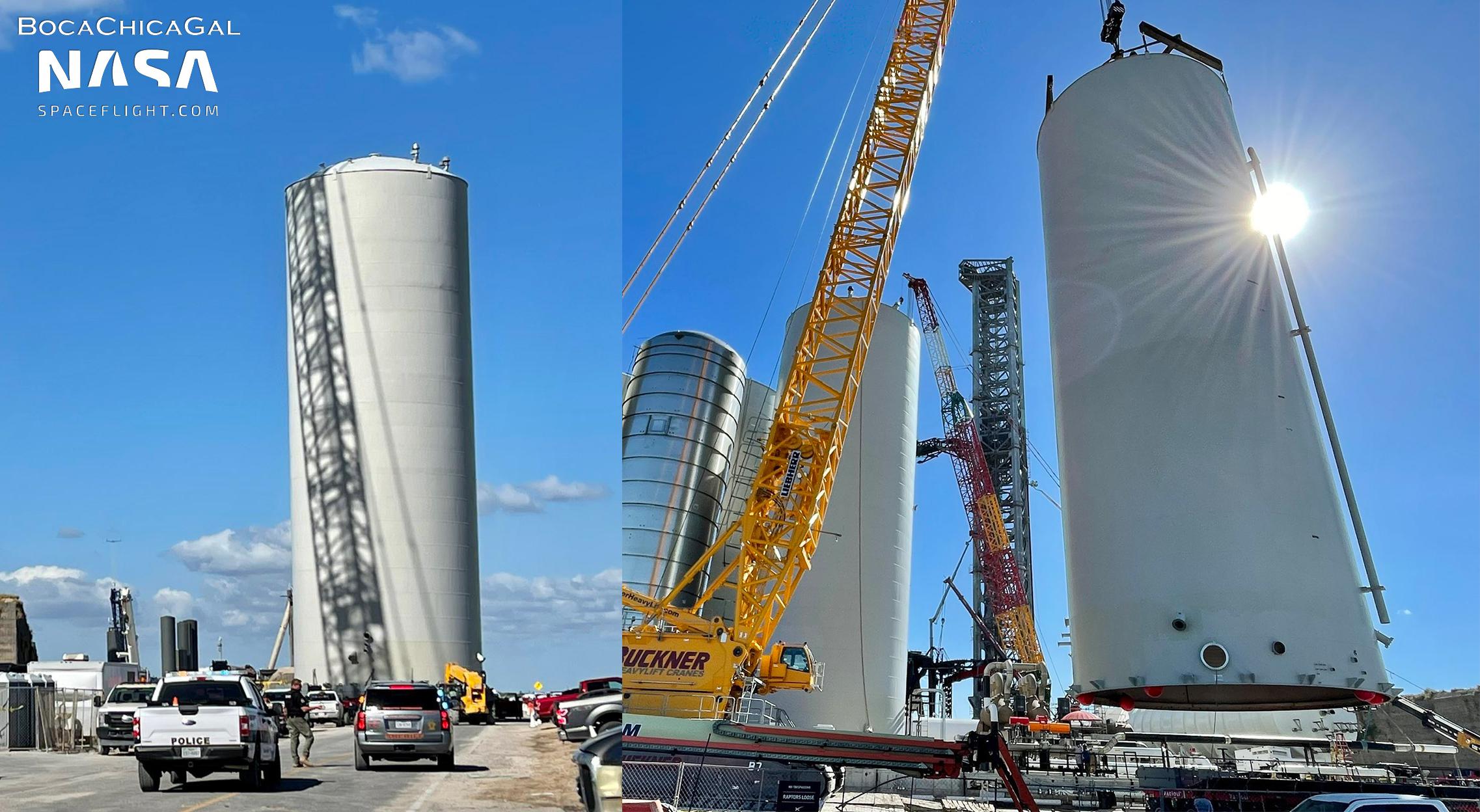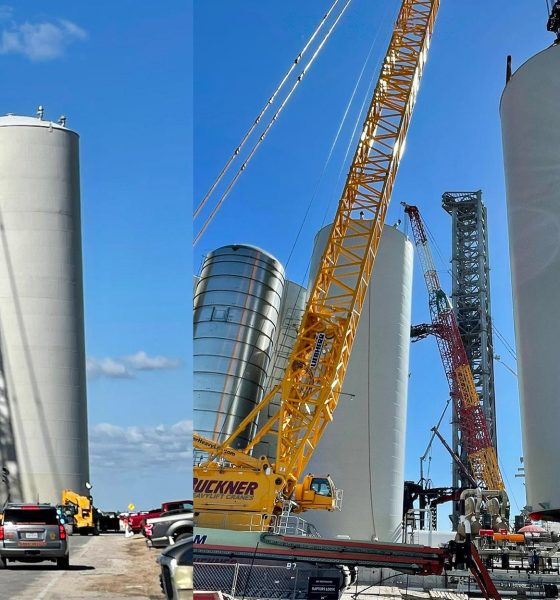

News
SpaceX rolls second-to-last ‘cryoshell’ to Starbase’s orbital tank farm
In the last two days, SpaceX has transported a giant mystery tank and the second-to-last ‘cryoshell’ to Starbase’s orbital tank farm, pushing Starship’s first orbital-class launch site a step closer to completion.
While the horizontal tank moved to the pad on Sunday remains decidedly mysterious, the ‘cryoshell’ is a well-understood component of SpaceX’s custom-built solution to Starship and Super Heavy propellant storage. Unlike virtually all other modern orbital launch sites, including SpaceX’s three Falcon pads and suborbital Starship test site, the company decided to build its first orbital-class Starship tank farm more or less from scratch. Though the number of off-the-shelf tanks continues to increase in recent weeks, the farm’s primary tanks – tasked with storage thousands of tons of liquid oxygen and methane propellant and liquid nitrogen coolant – are essentially stretched and lightly modified Starships.
Built in the same Starbase facilities with the same techniques and out of the same parts as Starship tanks, SpaceX’s custom storage tanks are likely cheaper than alternatives. However, they still amount to thin, uninsulated steel tanks – about as bad a vessel as it gets for the stable storage of cryogenic fluids. To solve the problem of insulation, SpaceX split the difference between pure vertical integration and a pure off-the-shelf solution and contracted with a third party to build massive ‘cryoshells’ – 12m (~40 ft) wide cylinders that ‘sleeve’ SpaceX’s custom 9m (~30 ft) wide storage tanks.
For the first of several anticipated orbital Starship launch pads and tank farms, that contractor built eight shells for SpaceX – seven sleeves and one million-gallon water tank. Over the last six months, SpaceX has installed the water tanks, completed all seven custom-built propellant storage tanks, and ‘sleeved’ five of those tanks. Beginning in September, two or three of the five sleeved tanks have even graduated into cryogenic proof testing.
Just days ago, SpaceX also began delivering liquid oxygen (LOx) to the orbital tank farm for the first time ever, suggesting that the company has begun the slow process of filling one, two, or even all three of the farm’s LOx tanks with a small army of tanker trucks.
On Monday, October 18th, SpaceX rolled the first of the last two remaining cryoshells from their build site to the orbital tank farm. Hours later, SpaceX attached a crane, lifted the sixth cryoshell, and sleeved GSE tank #8 – the second of two methane tanks. With that installation out of the way, there’s now a good chance that Starship’s first orbital tank farm will be structurally complete by the end of the month. With a vast majority of plumbing already in place and the process of filling the spaces between cryoshells and GSE tanks with insulating foam already underway, it’s possible that the farm will be ready to support some level of Super Heavy wet dress rehearsal and static fire testing sometime next month.
In the meantime, there remains the mystery of a pair of massive horizontal liquid methane (LCH4) tanks – the first of which was installed at the orbital tank farm on Sunday, October 17th. Likely capable of holding about as much fuel as each of SpaceX’s two custom-built LCH4 storage tanks, it’s unclear why the company appears to be effectively doubling the orbital pad’s LCH4 storage capacity with the addition of two new tanks purchased off the shelf.

News
Tesla FSD fleet is nearing 7 billion total miles, including 2.5 billion city miles
As can be seen on Tesla’s official FSD webpage, vehicles equipped with the system have now navigated over 6.99 billion miles.

Tesla’s Full Self-Driving (Supervised) fleet is closing in on almost 7 billion total miles driven, as per data posted by the company on its official FSD webpage.
These figures hint at the massive scale of data fueling Tesla’s rapid FSD improvements, which have been quite notable as of late.
FSD mileage milestones
As can be seen on Tesla’s official FSD webpage, vehicles equipped with the system have now navigated over 6.99 billion miles. Tesla owner and avid FSD tester Whole Mars Catalog also shared a screenshot indicating that from the nearly 7 billion miles traveled by the FSD fleet, more than 2.5 billion miles were driven inside cities.
City miles are particularly valuable for complex urban scenarios like unprotected turns, pedestrian interactions, and traffic lights. This is also the difference-maker for FSD, as only complex solutions, such as Waymo’s self-driving taxis, operate similarly on inner-city streets. And even then, incidents such as the San Francisco blackouts have proven challenging for sensor-rich vehicles like Waymos.
Tesla’s data edge
Tesla has a number of advantages in the autonomous vehicle sector, one of which is the size of its fleet and the number of vehicles training FSD on real-world roads. Tesla’s nearly 7 billion FSD miles then allow the company to roll out updates that make its vehicles behave like they are being driven by experienced drivers, even if they are operating on their own.
So notable are Tesla’s improvements to FSD that NVIDIA Director of Robotics Jim Fan, after experiencing FSD v14, noted that the system is the first AI that passes what he described as a “Physical Turing Test.”
“Despite knowing exactly how robot learning works, I still find it magical watching the steering wheel turn by itself. First it feels surreal, next it becomes routine. Then, like the smartphone, taking it away actively hurts. This is how humanity gets rewired and glued to god-like technologies,” Fan wrote in a post on X.
News
Tesla starts showing how FSD will change lives in Europe
Local officials tested the system on narrow country roads and were impressed by FSD’s smooth, human-like driving, with some calling the service a game-changer for everyday life in areas that are far from urban centers.

Tesla has launched Europe’s first public shuttle service using Full Self-Driving (Supervised) in the rural Eifelkreis Bitburg-Prüm region of Germany, demonstrating how the technology can restore independence and mobility for people who struggle with limited transport options.
Local officials tested the system on narrow country roads and were impressed by FSD’s smooth, human-like driving, with some calling the service a game-changer for everyday life in areas that are far from urban centers.
Officials see real impact on rural residents
Arzfeld Mayor Johannes Kuhl and District Administrator Andreas Kruppert personally tested the Tesla shuttle service. This allowed them to see just how well FSD navigated winding lanes and rural roads confidently. Kruppert said, “Autonomous driving sounds like science fiction to many, but we simply see here that it works totally well in rural regions too.” Kuhl, for his part, also noted that FSD “feels like a very experienced driver.”
The pilot complements the area’s “Citizen Bus” program, which provides on-demand rides for elderly residents who can no longer drive themselves. Tesla Europe shared a video of a demonstration of the service, highlighting how FSD gives people their freedom back, even in places where public transport is not as prevalent.
What the Ministry for Economic Affairs and Transport says
Rhineland-Palatinate’s Minister Daniela Schmitt supported the project, praising the collaboration that made this “first of its kind in Europe” possible. As per the ministry, the rural rollout for the service shows FSD’s potential beyond major cities, and it delivers tangible benefits like grocery runs, doctor visits, and social connections for isolated residents.
“Reliable and flexible mobility is especially vital in rural areas. With the launch of a shuttle service using self-driving vehicles (FSD supervised) by Tesla in the Eifelkreis Bitburg-Prüm, an innovative pilot project is now getting underway that complements local community bus services. It is the first project of its kind in Europe.
“The result is a real gain for rural mobility: greater accessibility, more flexibility and tangible benefits for everyday life. A strong signal for innovation, cooperation and future-oriented mobility beyond urban centers,” the ministry wrote in a LinkedIn post.
News
Tesla China quietly posts Robotaxi-related job listing
Tesla China is currently seeking a Low Voltage Electrical Engineer to work on circuit board design for the company’s autonomous vehicles.

Tesla has posted a new job listing in Shanghai explicitly tied to its Robotaxi program, fueling speculation that the company is preparing to launch its dedicated autonomous ride-hailing service in China.
As noted in the listing, Tesla China is currently seeking a Low Voltage Electrical Engineer to work on circuit board design for the company’s autonomous vehicles.
Robotaxi-specific role
The listing, which was shared on social media platform X by industry watcher @tslaming, suggested that Tesla China is looking to fill the role urgently. The job listing itself specifically mentions that the person hired for the role will be working on the Low Voltage Hardware team, which would design the circuit boards that would serve as the nervous system of the Robotaxi.
Key tasks for the role, as indicated in the job listing, include collaboration with PCB layout, firmware, mechanical, program management, and validation teams, among other responsibilities. The role is based in Shanghai.
China Robotaxi launch
China represents a massive potential market for robotaxis, with its dense urban centers and supportive policies in select cities. Tesla has limited permission to roll out FSD in the country, though despite this, its vehicles have been hailed as among the best in the market when it comes to autonomous features. So far, at least, it appears that China supports Tesla’s FSD and Robotaxi rollout.
This was hinted at in November, when Tesla brought the Cybercab to the 8th China International Import Expo (CIIE) in Shanghai, marking the first time that the autonomous two-seater was brought to the Asia-Pacific region. The vehicle, despite not having a release date in China, received a significant amount of interest among the event’s attendees.








